Creative Computing, November 1981
 One bit of old computer literature that I’ve managed to hang onto over the years is the November 1981 issue of Creative Computing magazine, which billed itself as “The #1 magazine of computer applications and software” and was one of the first computer magazines on the market.
One bit of old computer literature that I’ve managed to hang onto over the years is the November 1981 issue of Creative Computing magazine, which billed itself as “The #1 magazine of computer applications and software” and was one of the first computer magazines on the market.
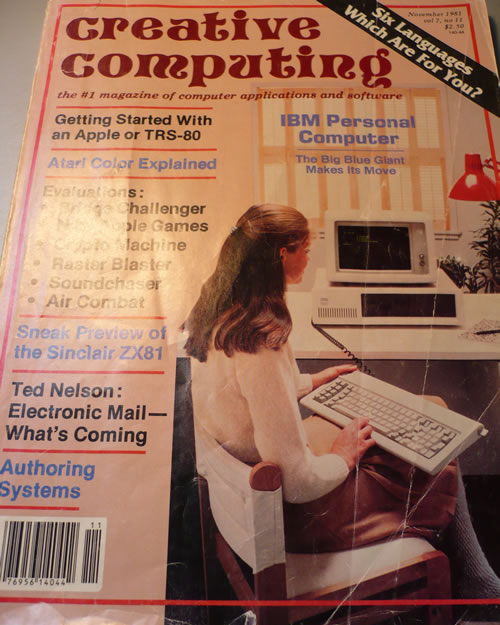
One of the stories in that issue was an article by Ted “Xanadu” Nelson titled Mail Chauvinism: The Magicians, the Snark and the Camel, in which he describes what happened at the Electronic Mail and Message Conference in Washington D.C. back in December 1980.
Nelson’s article covers a clash between technology and business that the modern reader will find familiar. On one side are the wizards, a number of people who worked at Xerox PARC and were using windowing GUIs and email systems that we think of as rather ordinary today, but were nothing short of magical back then (when a first-generation IBM PC with 64K RAM, 5 1/4″ floppy drive, a monitor and no hard drive would retail for US$3000). On the other side was the U.S. Postal Service, who saw mail, whether in paper or electronic form, as their rightful domain.
The present-day reader — especially those who are also readers of this blog — would be impressed by the prescience of the wizards at PARC, whose way-out ideas in 1980 are the bread and butter of technology today. Present-day readers will also be disappointed (but not surprised) by the protectionist attitudes of the U.S. Postal Service and the people in their camp; they’ll also get a feeling of deja vu, as a battle of a similar sort in going on today, this time between the copyfighters and organizations like the MPAA and RIAA.
In this blog posting, I’ll post the main body of Nelson’s article. I’ve posted this article in other blogs before, but those blogs are now defunct, and I believe that the article is still relevant today, partly because of the “technology vs. entrenched business interests” battle covered within, and partly because the predictions made by people quoted in the article are either eerily prescient or unintentionally hilarious in a 2007 context.
The article came with a number of sidebar articles, which I’ll post in later blog entries.
Prologue
It may not look it, but much of the action in computers has already ended. In the next decade they’ll simply stamp out machines like those we already know although with new interconnections, at lower and lower prices with, we hope, better and better software.
But the real action now is in Networks, Protocols, Standards, Standards, Encryption and Databases; and at least one war of shadows in Washington may determine our freedoms as users and citizens. And you may have already won! But eternal vigilance is the price of freedom, so read carefully.
The Snark
In Lewis Carroll’s epic poem, The Hunting of the Snark, a party of very dissimilar Victorian gentlemen all go off to catch something called the Snark. The real catch, however, is that though all think they are after the same thing, each has an utterly different preconception of what a “Snark” must be, an image conjured up from each man’s background and preconceptions.
This allegory will be found suggestive in many branches of the computer field. At the Electronic Mail and Message Conference, its relevance was particularly striking,
The Electronic Mail and Message Conference (hereafter M&M) was held in Washington on December 11 and 12, 1980 — the waning days of the Carter administration. Sponsored by numerous federal agencies and committees of Congress, and by AFIPS, the computer society of all computer societies, it took place in a huge oak-panelled room in the Sam Rayburn Office Building. The room was called, by a sign on the door, “Committee on Interstate and Foreign Commerce.”
The conference began in an atmosphere of excitement and would down from there. When it began, at 8:00 a.m. Thursday, the room was tense and crowded, packed with hundreds of people, and the rows of officials’ chairs that stared down at us were mostly full. But the next morning only half as many came, and only a few were left at the close.
But the beginning started in a crackling atmosphere. Middle-aged executives looked quizzical, elegantly-dressed young lawyers grinned smugly, nervous reporters looked cowed. (“What do Electronic Mail and Message Systems have to do with news?” pleaded their eyes.) Almost everybody was well-dressed and had short hair. Many or most of the technical speakers were bearded, but few of the audience.
There were some exhibits downstairs of on-line systems (unfortunately not including Arpanet, which was often mentioned). Tasteless lunches were served by listless waiters, though a marvelous open-bar buffet miraculously appeared after the first day.
Mainly the conference was a rapid-fire succession of speakers, tightly paced from 8:00 a.m. to 5:00 p.m. for two days — a note-taker’s nightmare. In the ensuing months I believe I have been able to figure out the major themes and issues, even though the speakers were randomly sequenced and spoke in different tongues.
Rather than tell about the speakers in the order they spoke, requiring you to untangle many separate threads, I will describe as coherent sequences various stories that actually came through to us piecemeal and in random order. In this article I will try to present the new things I learned and the principal issues, as expressed by some of the strong personalities present.
Several different school of “electronic mail” were present at the M&M Conference, though not all were spoken for from the platform.
Two main views were heard, though there are several more:
- One was the idea that electronic mail is in some sense a simple replacement of paper mail, which the Post Office speakers seemed to think.
- The other view sees “electronic mail” as just one fact of the coming world of transmissive computing in which a lucky few already live.
The speakers can be divided into several groups:
- Outstanding were the three I call “the magicians,” whose presentations of a computer tomorrow went far beyond electronic messages, though electronic messages formed an integral part of their presentations.
- Another group, “the packeters,” explained the various conceptual levels of packet communications and packet networks — the highways, and rules of the road, for this tomorrow.
- Another group spoke of dividing the electronic spectrum and when you should buy satellites; regretfully, I must omit discussing them.
- Then came representatives and spokesmen for the U.S. Postal Service, essentially explaining why they felt a need and a right to control electronic mail as they saw it.
- And finally, numerous “regulators” — government lawyers and administrators — told us about regulating the spectrum (which I must skip) and regulating private services and the post office (which must be covered).
 A surprising political issue surfaced at the conference: the role demanded by the U.S. Postal Service in a new world they claim to understand but may not. What the Postal Service wants to do might narrow and restrict what you can do in the future with your computer. At present there is a compromise, but these political issues may resurface at any time.
A surprising political issue surfaced at the conference: the role demanded by the U.S. Postal Service in a new world they claim to understand but may not. What the Postal Service wants to do might narrow and restrict what you can do in the future with your computer. At present there is a compromise, but these political issues may resurface at any time.
The lines appear to be tightly drawn. On the second afternoon a lady in the audience told me she was the only remaining attendee from the Postal Service — the other three had left.
Representative Rose
In a way the first luncheon speaker and his enthusiasm perfectly embodied the ideas and controversy of the conference. This was Representative Charles Rose (D., N.C. [that’s Democrat, North Carolina for our international friends — Joey] , who wore a strinking plaid jacket. He heads the Policy Group on Information and Computers of the Committee on House Administration of the House of representatives, and is chairman of the House Agriculture Subcommittee on Dairy and Poultry.
A computer enthusiast, Rep. Rose was introduced as having a “split screen bulletin board.” Congress, he told us, has budgeted for an “informational terminal” for every member of Congress. The two approved brands are Hazeltine and TI. A portable is given out only if the member signs a paper “agreeing to be trained in its use.” Freshmen congresspersons have found this very appealing. Rep. Rose told us that at the next Congressional seating, the House would get a full view of electronic mail — now that “Old Stonehead,” whose name I did not catch, was retiring from some post or another.
![[Representative Rose] is also interested in forms of teleconferencing for members [of Congress]; he would like to “create an electronic place where we can meet as friends in private.” But he was concerned for the use of these new media back in the districts. “I want Granny at home, with her video text to be able to use this too.”](http://globalnerdy.com/wordpress/wp-content/uploads/2007/09/pull_quote_2.gif) Many letters pass between congressmen, he told us, particularly “Dear Colleague” letters about their individual concerns., that go out to all fellow members. A representative reads the ones from certain people and not others, he explained, and he would like to be able to automate this — including the screening out of the unwanted material. He is also interested in forms of teleconferencing for members; he would like to “create an electronic place where we can meet as friends in private.”
Many letters pass between congressmen, he told us, particularly “Dear Colleague” letters about their individual concerns., that go out to all fellow members. A representative reads the ones from certain people and not others, he explained, and he would like to be able to automate this — including the screening out of the unwanted material. He is also interested in forms of teleconferencing for members; he would like to “create an electronic place where we can meet as friends in private.”
But he was concerned for the use of these new media back in the districts. “I want Granny at home, with her video text to be able to use this too.” And he would like to see public-access write-your-congressman terminals.
Unexpectedly, Rep. Rose spoke on what would be the political issue of the conference. “The U.S. Congressman has many friends,” he intoned, “and one of these if the U.S. Postal Service.” And so, he explained simply, he wants Electronic Mail to be beneficial to the Post Office. We will return to this point later.
The Wizards
During the opening remarks, Bob Taylor sat and listened like a college president: his gaze one of Olympian calm and warmth; musing, sympathetic, but impassive. He looks still in his thirties, but can’t be; since he was head of Arpa/Ipt over a decade ago [remember, this event took place in December 1980 — Joey] .
Taylor is the manager of the Computer Science Laboratory of Xerox PARC. The people there do the most powerful and exciting things in the whole computer community, and he is their shepherd. It is rather like a shepherd fondly inspecting a bleating flock that he addresses us.
Taylor takes a poll of the group. Half the audience had used “electronic nets” (whatever they mean by that); but only a third had written a program. (This suggests that half scarcely knew what a computer was.)
Onward nevertheless. Taylor explains that one of the special features of electronic messages is that they are read at the receiver’s convenience, waiting somewhere till he is ready. And that since they are really brought to us by and through computers, message systems are “software-intensive”, requiring programming development on a grand scale.
He rolls the videotape. On screen we see Taylor at his Alto, the famous PARC hot minicomputer with the finely detailed screen. We see the screen divided into many fields, which part like the Red Sea as Taylor on the screen points first at one thing, then another. A prompt tells him that messages are waiting; he reads them, replies, acts, discards, causing various rearrangements of the screen with offhand magical passes of the hand.
One note we see him read on the screen causes him to change a schedule; another he tells, effectively, “Go file yourself.” One note he sends electronically to several other people, selecting them by flicking their names from a list that appears.
Taylor explains this as he goes. “My message system is more than a message system,” he understates.
Fields of text rearrange themselves on the screen, compress, expand. Sometimes the moving cursor is a box, sometimes an hourglass, sometimes something else. So quickly and effortlessly do the messages come and go on Taylor’s Alto screen, you hardly realize that the work you see him doing would be a storm of activity if he were shuffling actual paper.
(The audience is studious but impassive. I get the feeling that only a few understand what they see — those who already know about it — but the rest of the audience doesn’t know what it’s about and can’t tell.)
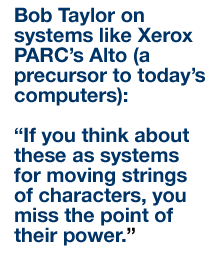 These messages we see the videotaped Taylor working with are not mere telegrams that go from one person to another and stop. Rather, he may search and scan through them, alter them, pass them on, or reply, with a flick of the wrist; they roll and fly before his face like the cards of a riverboat gambler. Some of the involve graphics and color and audio. “If you think about these as systems for moving strings of characters, you miss the point of their power,” he says.
These messages we see the videotaped Taylor working with are not mere telegrams that go from one person to another and stop. Rather, he may search and scan through them, alter them, pass them on, or reply, with a flick of the wrist; they roll and fly before his face like the cards of a riverboat gambler. Some of the involve graphics and color and audio. “If you think about these as systems for moving strings of characters, you miss the point of their power,” he says.
The phrase “Office of the Future” has been bruited about a great deal in Xerox publicity, as in “we’re developing the Office of the Future at Xerox PARC,” but of course who can agree on what that means? Yet here it is in front of us: the paper trivia-flows of the office are calmly controlled on the Flatland of the screen. I don’t know what the paperwallopers at Xerox Corporate think of the Office of the Future may be, but I’ll gladly settle for this one.
What we see Taylor working with is still in fact a world of documents, separate, potentially printable on paper. But here is the kicker. Less than 1% of the electronic messages at PARC, he tells us, are printed out.
Wizard Two is Michael Dertouzos of MIT. he heads what used to be called Project MAC, where time-sharing began; now it has 300 employees and a more boring name, the Laboratory for Computer Science. He is tall, dashing, accented, ought to wear a cape.
As computer prices go down 30% a year, he says, hidden computers will proliferate everywhere, just like the “hidden motors” that we know as hair dryers and such.
He shows us screen-views of his own personal files: a schedule (which becomes a history file as it slides through the present), his list of associates and acquaintances (cross-filed by name and city, so he can fill his travels with companionship), his checkbook (which automatically categorizes everything).
And he shows us how message systems of the future might let us go shopping. Suppose he wants a certain kind of wallet. His computer now makes inquiries at various shopping data banks, looking for wallets of the right size and color, and makes notes on which ones come closest to the desired configuration.
Wizard Three gives us a conceptual framework for thinking about this world. He is J. C. R. Licklider, called Lick by everybody. Warm and cheery, Lick is a founder of time-sharing, past director of MAC and Arpa pioneer. (Starting up the computer work at Arpa, he financed Ian Sutherland’s Sketchpad.) One of the greats.
Licklider foresees a world where “all intellectual functions are well supported by computers.” (Right now, we have “access to gigabits through punybaud,” but that will change.)
Licklider’s messages and examples on the screen now involve fill-ins and subroutines and modeling. He shows how he can program his computer to make dinner arrangements when he goes to a certain city: if the first person invited can’t have dinner, his computer scans the list of his other friends in the same city and issues dinner invitations to them . All this in a simple conditional language.
But rather than talk about “computers,” whose actual whereabouts and boundaries become indeterminate in this sort of a coming world, Lick prefers to talk about “agents” or “assistants,” things you set up to do things for you. (Lick also likes to call them Olivers, after Oliver Selfridge, who came up with the idea around 1966.) Agents will handle “augmented telephone calls,” stacking the calls and pushing them through automatically. Agents will pay your bill, checking them against the appropriate invoices in standard electronic forms. They will sniff out information a friend may have set out: his birthday, gift preferences and sizes, party invitations, information he would like from whoever knows it.
Agents will not merely receive messages; they will react to them, sending out new feelers, and requests to other computers and agents. Messages, forking and thrusting through a forest of computers and agents, will inquire, update and reply, often waiting for interactive responses. Messages will independently link to animated diagrams and status displays, keeping them current.
Subprograms call each other in ternally all the time, says Lick; soon they’ll be doing it ex ternally, sometimes in parallel, sometimes queuing. So the interchange of “messages” becomes something larger, a crossfire of interacting events.
But now you see this messaging is something else. It is not postcards or telegrams, it is not document handling. In its back-and-forthing it is more like the telephone than the telegraph. It is a new form of closely responsive session, a chain-reaction system of intercommunication among — what? Agents. Places. Databases. Programs, texts, indications, semaphores. It is a pool-table model, like a gunbattle, like atomic nuclei near critical mass: the event-shower-interchange session. A shower of sparks.
The Camel
Across this landscape of cheery electronic possibilities there came, but not so very long ago, an interesting intruder: the United States Postal Service.
You have heard of camels. You have undoubtedly also heard the expression, “When the camel gets its nose inside the tent, the rest will follow,” or some exotic equivalent, intended to convey the idea that the rest of a camel cannot be far behind its intruding tip, and all of the camel will soon be within any environment it penetrates.
Now before this parable can be fully explained, and we can get back to the conference, it is necessary to fill in some facts and history.
By law, the Post Office has monopoly power over delivered things. You cannot, for instance, open a delivery service between cities except under certain specific, narrow conditions. (And symbolically, you must have U.S. stamps on the parcel your service brings.)
This is the infamous “delivery monopoly.” At least one M&M speaker, Lloyd Johnson, spoke as though there were a danger that the post office might attempt to extend this monopoly to all electronic messages . This also seemed to be the position presented by Jaquish of the Postal Service, who spoke as if the Postal Service had a natural right that extended into this new realm.
In 1978 the Post Office proposed to open a new service, called E-COM (Electronic Computer Originated Mail; the hyphen is something of a mystery).
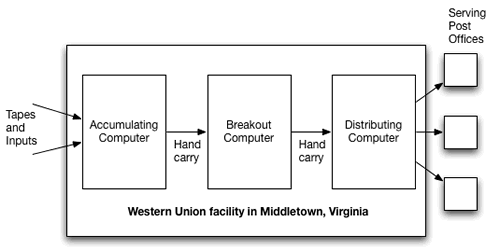
Original proposed design for E-COM (Electronic Computer-Originated Mail). This was proposed by the U.S. Postal Service in 1978.
Now, the Post Office cannot just do anything it wants. It must get permission from the Postal Rate Commission, making formal proposals for new services.
The Post Office proposed in 1978 to connect very large mail-senders — those sending thousands of pieces a year — to a centralized computer system. (This would be Western Union’s facility in Middletown, VA.)
In this original proposal, a large variety of inputs would bring messages to the Western Union computer. Bills and form letters would be repetitively copied, electronically, with appropriate names, amounts and other fill-ins,; then these finished telegraphic communiquŽs would be sent electronically to 25 major “serving offices,” where their contents would be printed out, stuffed in envelopes and delivered with the regular mail.
The proposal has several problems. One was technical ghastliness: tapes being carried across separate computers, for instance. Another was high cost (30 to 60 cents a letter). Then came some deeper problems: in selling electronic transmission services, the Post Office would be competing with several common carriers. This further threatened a monopoly fight related to the Post Office’s monopoly prerogative of delivery, threatening (at worst) that whatever electronic mail might become would only be what the Post Office allowed it to become. And finally and darkly, archival copies of tapes were to be kept.
This proposal was brought before Albert Vezza, MIT Professor and one of the architects of the Arpanet. He proposed a rather straightforward alternative: no centralized facility, and the use of common carriers — available electronic nets — between the serving post offices, where the printing and the stuffing and delivery would occur.
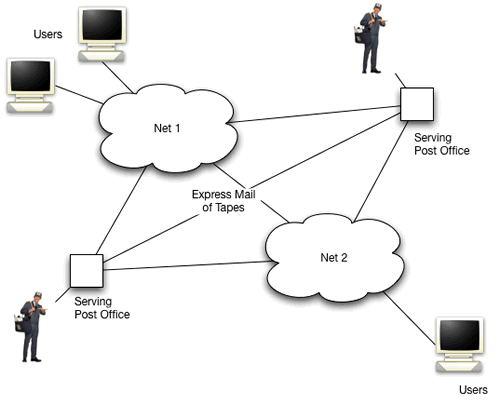
E-COM proposal, as modified by Albert Vezza and the Postal Rate Commission. This was slated for implementation by RCA in 1982.
This was simpler. It did not compete with common carriers, but used them. And it cost about ten times less per piece.
The two alternatives — the original one and Vezza’s — were brought before the Postal Rate Commission, which decides these things. There was a bitter fight. The PRC’s decision: “implement the Vezza alternative.” The Post Office fought this decision in the courts, but had to give in. Finally it was accepted by the Post Office board of governors, but they then turned around and filed a lawsuit against the Postal rate Commission to make the new arrangement permanent before it had even tried — that very arrangement they had just been fighting.
The new system will supposedly be implemented in 1982. (As of this writing, the Post Office has accepted a proposal from RCA, but its contents have not yet become available.)
One leading and mischievous feature was added to the Vezza alternative in the ECOM system that was finally approved. This was an input link direct to the serving post offices. However, since the Postal Service was explicitly forbidden to provide end-to-end service (“generation three”), information received in this fashion is to be put on magnetic tape and sent by express mail to receiving post offices . (It is as though this step were undertaken explicitly to be inefficient, and cry out for the electronic completion that is not now allowed. A cynic might say the feature was put there as a festering inconvenience, crying out for proper electronic consummation and thus challenging the present compromise.)
This was essentially the view of Henry Geller (see “The Regulators”) — that the Post Office will be continually maneuvering to add electronic services until it has “the whole thing,” a monopoly of delivery to your own terminal. With ECOM, ” The camel’s nose is under the tent ,” says Geller.
What is anticipated in these early stages, since only high-volume mailers may play the game, are corporate mass mailings such as dunning letters, product recalls, bills and special advertising. A special advantage of ECOM is its ability to put special Text Insert Messages (TIMs) into COmmon Text (COT), adding all the John Smiths to supposedly personal messages. It seems this would save considerable in-house effort along the same lines for major mailers.
The Conference Again
Now here we are at the conference again, and we will hear some spokesmen from the Post Office.
First comes the head of R&D for the Post Office, Paul Jaquish. He is slow-spoken, balding, somewhat angry-seeming; his title is Senior Assistant Postmaster General, Research and Technology Group of the U.S. Postal Service.
He comes on as the heavy with a belligerent and defiant manner. Here is what I got down.
- “We must control service .”
- “We cannot allow our resources to be spirited away.”
- And finally: “We have a legislative mandate and a financial requirement.”
Well, at least it’s up front. But what did it mean? Was he talking only about delivery on foot? Or is he telling us their electronic must eventually be the only ones that make messages available to our personal computers? It certainly sounded to me as though Jaquish said, essentially: “Whatever this is, it belongs to us.”
When it came time for questions, I tried to ask the question that was burning on my mind, but it took too long. I said something like: “The format of this conference suggests a premature delineation of ‘mail and message’ systems, arbitrarily cutting them away from teleconferencing, data bases, highly interactive environments, electronic publishing and archiving. Could you comment?”
Jaquish’s one-syllable answer got a big laugh, and we broke for the first lunch.
The next day we heard Vincent Sombrotto, president of the National Association of Letter Carriers and its 233,000 members. That’s right, a quarter of a million.
Sombrotto was fiftyish, with white hair and a ruddy complexion. The former president of the New York branch of the union, he had a Jimmy Durante Brooklyn accent and just about as much charm. Everyone seemed to find him unexpectedly likeable.
Sombrotto addressed himself, naturally, to the question of what should be the role of postal personnel in electronic mail. I got down just three quotes.
- “It’s da most efficient postal soivice in da woild.”
- “If da wave of da future is electronic transmission of mail, den it only makes sense to use da most efficient awganization in da woild.”
- “If dis seems self-soiving (cheery grin), dat’s exactly what it’s meant to do.”
A Remarkable View
The most astonishing presentation was certainly that of Charles Joyce. Formerly Directory of Information Technology and Policy at the Mitre Corporation, and now consulting to the Post Office. He is a member with a somewhat smug air and rather remarkable views.
Mr. Joyce had made a study of the “existing mainstream,” that is, the things the Post Office delivers now. The question they tried to answer was what kinds of mail would be directly replaced electronically, or “diverted,” according to this way of thinking.
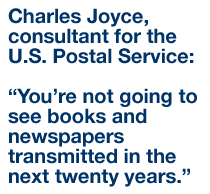 The projections appear to hold approximately constant the number of messages per capita. The figures we saw foresee a slow drop in conventional mail as “generation two” and “generation three” get off the ground. And Joyce announces confidently: “You’re not going to see books and newspapers transmitted in the next twenty years.”
The projections appear to hold approximately constant the number of messages per capita. The figures we saw foresee a slow drop in conventional mail as “generation two” and “generation three” get off the ground. And Joyce announces confidently: “You’re not going to see books and newspapers transmitted in the next twenty years.”
What makes him think the number of messages will stay the same? “We did not include the stimulation factor,” he said.
Now this is most interesting: it assumes that each electronic message replaces a sheet of paper folded in an envelope or some other enclosed packet of markings on cellulose. And it assumes a very constant universe. (Projections are often presented for varying sets of assumptions, none yet know to be true. No such fiddle-faddle here.)
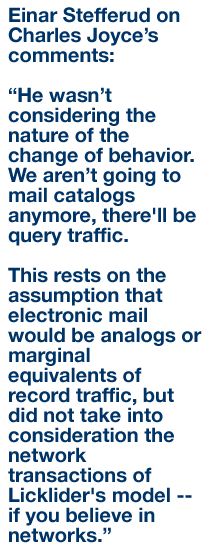 Mr. Joyce’s remarks were later commented on by Einar Stefferud, a consultant attending the conference.
Mr. Joyce’s remarks were later commented on by Einar Stefferud, a consultant attending the conference.
“He wasn’t considering the nature of the change of behavior. We aren’t going to mail catalogs anymore, there’ll be query traffic.”
Stefferud continued, “this rests on the assumption that electronic mail would be analogs or marginal equivalents of record traffic, but did not take into consideration he network transactions of Licklider’s model — if you believe in networks.”
Only time will tell, of course, but any observer would be reminded here of the projection made in 1947 that half a dozen of that day’s computers (each with the about the power of an Apple) would satisfy the United States for the foreseeable future.
Or consider the market research of the Haloid corporation, whose investigators repreatedly reported that the copying machine Haloid was working on would only sell a few dozen before exhausting all the demand in the United States. (When the copier was finally introduced, Haloid changed its name to Xerox.)
The Friday lunch speaker was Lloyd Johnson, a poised and impressive individual and staff director of the House of Representatives’ Subcommittee on Postal Operations and Services. He sounded a less enthusiastic note for the Post Office than had Rep. Rose.
One of Johnson’s first remarks was that everyone was proceeding from different assumptions, perhaps the best point made at the conference. He then went on to outline the history of the Post Office’s maneuverings to institute electronic mail service, based on the notion that growing use of electronic messaging constituted “first-class mail diversion,” as though someone were taking away what rightfully belonged to the Post Office, like the ballpoint pens on chains.
Hair-raising estimates from various sources project staggering amounts of electronic communication. One commentator estimated that 220 million people would be sent ten items a day each averaging 30K bits per item. (Have you a better guess?) Vezza’s earlier Congressional testimony had foreseen between 230 million and five billion electronic messages in 1983, which would already be as much as ten percent of the mail!
Other consultants foresaw twelve and a half billion pieces “diverted” in 1990, twenty-six billion in 2000.
So whatever it is, it’s important. And it is not surprising that the postal workers are agitating for a piece of this action, which Johnson called “turfmanship,” even though the General Accounting Office has estimated that “any loss” to the P.O. could be covered by attrition.
HUMPH: A Concluding Editorial Opinion
Some of the finest minds of our time are trying to build a new world of interactive communication and instantaneous availability of information, pictures, ideas, models, worlds.
Meanwhile, the Post Office has come to assume, in some innocence, that electronic message services are directly related to, and in competition with, what they already do — the “same thing” as letters on paper.
This “turfmanship,” as Lloyd Johnson called it, is strongly reminiscent of the typesetting-union problems faced by newspapers in the sixties, when the typesetters imagined that “new jobs” would be created in electronic typesetting to which they had a natural right — even though the actual new jobs involved computer programming, and were being carried out by vendors elsewhere. What is going to happen is something different .
There still exists the faint possibility that the Post Office might actually force a monopoly of its services in these new areas, based by some miraculous extension of law on its existing monopoly. The possibility is slight, because competitors would not stand for it and customers would not stand for it — besides which, of course, the is the Reagan administration’s stand against government services in general.
But most important, the Postal Rate Commission has in its wisdom given the Post Office that fraction of electronic communication which can be stuffed in an envelope.
However, that does not necessarily end the threat. The warnings of Henry Geller, for instance, centered on the difficulty of a mixed economy where the Post Office offered electronic services in competition with private vendors.
I see a different sort of threat: that the Postal Service might make electronic mail become what they think it is. And this could cripple us all for the indefinite future. At a point so early in the development of such services, it is astonishing that the Postal Service is already petitioning to make ECOM permanent . What if permanence had been legislated for the Ford Trimotor, the ENIAC computer and the SOAP language?
But it is in the further services the Post Office might offer — currently forbidden — that the danger lies. Even if they get no monopoly, by offering new services they have the power to structure an industry.
If the Post Office can, with flexibility, participate with this with as much foresight as those whose vision is driving it, then their participation will do no harm. But if Post Office participation means low-grade visions are to be foisted on the public, simplified and degraded forms of transmission that cripple the kind of interaction we are trying to create, the maneuverings are to be viewed with the greatest alarm by those who care about the world of tomorrow. Oversimplification and inflexibility could greatly reduce the imagination and power of tomorrow’s evolving services. Let us hope the Post Office can find the wisdom to expand its understandings, and make an orderly contribution to the structure of our new life of the future, rather than a narrow, monopolistic impediment to the world some of us are trying to create.
Epilog
In The Hunting of the Snark, the quarry all were seeking out turned out to be that most horrible of beasts, the Boojum. If the finest of visions are not shared as widely and clearly as possible, what Boojum may we not find?

One reply on “Mail Chauvinism, Part 1: The Magicians, the Snark and the Camel”
[…] Service is not going to impose a tax on all e-mail. But there was a time when they tried to become the sole controller of electronic mail. Blogger Joey deVilla unearthed a 1981 issue of Creative Computing that covers the Electronic Mail […]